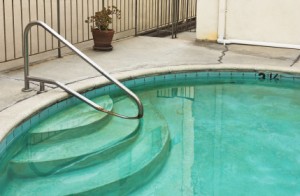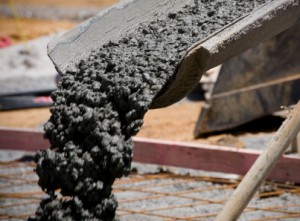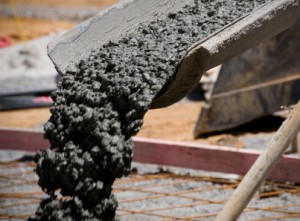Commercial asphalt parking lots are especially vulnerable to developing cracks during cold weather seasons. These cracks develop from the excess water vapor in the air, as well as snow, ice, and rain that frequently fall during late autumn and winter. However, if asphalt cracks develop, there are some solutions that PTG Enterprises is eager to provide to retain the integrity of your asphalt pavement. Read on to learn the specific asphalt repair jobs required to fix those pesky asphalt cracks. (more…)
Blog
Archive for the ‘Crack Sealing’ Category
Why Asphalt Cracks and How to Repair It
Wednesday, October 23rd, 2019Crack Fill Before Winter To Prevent Freeze/Thaw Damage
Friday, October 19th, 2018Winter is just around the corner, and it’s important to start preparing your parking lot and pavement to prevent freeze/thaw damage. If the asphalt has any cracks or potholes, now is the time to crack fill the pavement before the temperature gets too cold. Learn more about freeze/thaw cycles and why it’s crucial to crack fill your parking lot before winter arrives. (more…)
What Is Asphalt Seal Coating?
Friday, August 4th, 2017Seal coating is a true barrier between asphalt surfaces and the destructive elements. The term “seal coating” means keeping the redeeming properties of asphalt sealed in to prolong the pavement life and preserve its functional properties. The primary reason to sealcoat an asphalt pavement is to protect the pavement from the deteriorating effects of sun and water. When asphalt pavement is exposed to sun, wind and water, the asphalt hardens, or oxidizes. This causes the pavement to become more brittle. As a result, the pavement will crack because it is unable to bend and flex when exposed to traffic and temperature changes. (more…)
Prepare for Summer With Concrete Pool Deck Repair
Thursday, May 26th, 2016Summer is known for heat, heavy unexpected rain storms, and humidity. This generally moist atmosphere means that moisture can seep into the cracks in your concrete pool deck easily. The moisture of the cold winter can be especially damaging to concrete, the freeze thaw cycle leading to all sorts of concrete pool deck cracks and damage which needs to be repaired come spring in time to be enjoyed during the hot summer. It’s best to be as proactive about any concrete pool deck repair as possible. The earlier in the season, the better.
The Ins and Outs of Asphalt Pavement Maintenance
Thursday, September 25th, 2014A savvy businessperson knows that taking care of your business’ property is vital. It creates a welcoming environment for clients and shows that you put care, time, and energy into every aspect of your work. That’s why it’s worth spending the time to maintain your property’s asphalt pavement. Everyone knows that when a road’s condition deteriorates beyond a certain point, people won’t want to drive there, and less foot traffic means less business. PTG paving is here to stop pavement destruction before it starts with a bit of preventative maintenance advice.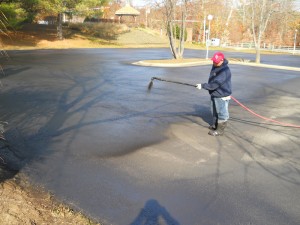
Crack Filling
While there’s ultimately no way to prevent the damage caused by the seasonal freeze-thaw cycle that causes most asphalt pavement damage, it can be quickly mitigated with crack filling. The process involves blowing out, cleaning, and then refilling cracks with one of a wide variety of emulsions, cements, or asphalt-variants which prevents water intrusion. It’s best used on wider cracks and the filling has a life expectancy of slightly less than 3 years.
Crack Sealing
A step that goes beyond crack filling, sealing provides a longer term solution. Crack sealing involves widening the crack substantially to about a 0.5-inch by 0.5-inch to 0.75-inch by 0.75-inch square. This space is then filled with rubberized asphalt material. The larger trench provides greater flexibility during thermal changes, as does the rubberized asphalt. Crack sealant is graded based on climate and temperature, so it’s important to apply one that works in your area’s specific environment. Crack Sealant has a life expectancy of about 3-5 years and is an excellent asphalt pavement maintenance option.
Surface Treatment
Also available in a slew of options, surface treatments can be used to repair and reinforce against small scale environmental damage over a larger area. Using emulsified asphalt that is usually either mixed with, or immediately followed by, a fine aggregate, several layers are applied to a large area. The surface treatment will fill small cracks and can penetrate into the asphalt pavement, waterproofing the surface and reinforcing the base while increasing overall elemental resistance.
Dangerous DIY
While it is possible to attempt these kinds of preventative measures yourself, improper mixing or application of the materials could be hazardous and ultimately make your asphalt less safe than before. That’s why it’s best to consult and hire a professional contractor for your asphalt pavement maintenance projects.
The asphalt paving experts at PTG Enterprises have managed hundreds of pavement projects throughout Baltimore, Maryland, Washington DC, and Virginia. You can expect a fair proposal, professionalism, and quality work.
A good contractor is hard to find!
If you have any questions about Pavement Repair and Crack Filling, please contact PTG Enterprises today by calling 410-636-8777, or click here today! Unlike those other asphalt contractors, we care about you and your business. In fact, when you hire PTG, you’ll work with owner Patrick Gillen from start to finish, from the initial site visit and pre-construction meeting to the final walk-through.
You can check us out on Facebook and Twitter as well!
Source: Buildings.com
Repairing Concrete Cracks
Monday, September 8th, 2014Concrete is a durable and reliable building material but even the toughest stuff has to be repaired someday. However, different types of concrete cracks will require different methods to repair them. Here are some steps you can take to repair different types of concrete cracks.
Narrow Cracks
Narrow concrete cracks can be repaired with Masonry Crack Filler that can be purchased in a cartridge form designed to be used in a caulking gun, or in a spreadable putty. First, remove any loose debris surrounding or in the crack with a brush or broom then use the fill the crack and smooth with a trowel.
Wide Cracks
Wider cracks will require more work. First, use a sledgehammer and chisel to widen the base of the crack so that the internal crack is wider than the surface, then clear away any debris. Mix together your vinyl patching compound as directed by the manufacturer and trowel it into the crack. Apply pressure to eliminate air pockets, then smooth with a trowel.
Slabs or Walks
Significantly damaged concrete slabs or walks are best repaired by fully removing and replacing the slab. This is a significantly larger job than repairing simple cracks and will involve more materials and preparation. First, use a sledgehammer to break up the damaged slab, and then remove the largest pieces of rubble while spreading the small ones to create a firm bed for the replacement. Next, set up wooden 2x4s around where the new slab will go. The top edges of the planks should be flush with where the top of the finished slab will sit.
Next, mix your concrete according to manufacturing instructions and dampen the area to be repaired. Fill the area with concrete by beginning in one corner and working towards the center, then selecting another corner and repeating until the concrete reaches the top of the planks. Use another, larger board to scrape away excess concrete and tap the sides of the boards to help settle the mixture. After the water has evaporated smooth the surface with a trowel and wait for the concrete to set. Then use your trowel to pry away the surrounding boards. Cover with a tarp and allow the concrete to cure according to your manufacturer’s instructions.
Need Help?
As you can see, repairing concrete damage can range from a relatively quick fix, to a lengthy process. Employing skilled masons, like those found at PTG Enterprises, can make this process an affordable snap and ensure that your concrete will be fixed quickly and properly.
PTG is a full service commercial concrete masonry contractor in the Baltimore, Maryland area. We’re experts at masonry jobs, whether it’s repairing retaining walls, architectural elements, dumpster corrals or storm drains, PTG Enterprises knows how to handle it.
We’re a paving company that knows how to hit the bricks!
If you have any questions about Concrete Masonry, please contact PTG Enterprises today by calling 410-636-8777, or click here today! You can check us out on Facebook and Twitter as well!
Sources:
Crack Sealing vs. Crack Filling: Your Baltimore Asphalt Contractor explains
Friday, February 8th, 2013As we explained last week, first impressions mean everything in business. Because of this, it is important to keep your parking lot in tip top shape. Still, no matter how much preventative maintenance you perform, your asphalt will eventually crack. The key to preserving your parking lot is to repair small asphalt cracks before they spiral out of control, eventually leading to more serious issues, like potholes or even total asphalt failure occur.

Crack Sealing vs. Crack Filling
There are two primary methods for dealing with asphalt cracks, crack sealing and crack filling. This prevents water and other foreign substances, like sand and dirt, from penetrating the asphalt surface and degrading the asphalt from beneath. Crack sealing and crack filling are the most cost effective pavement repair and maintenance techniques available. But which is better?
- Crack Filling: The less expensive of the two methods, crack filling may not last as long as crack sealing.
- Crack Sealing: Crack sealing is the more expensive method, but also the more durable method. While crack filling may only last one or two seasons, crack sealing can last up to 8 years or more.
So what matters more to you, initial expense or longevity?
PTG Enterprises: Your Baltimore Asphalt Contractor
When your parking lot is beginning to show signs of wear and tear, you need an expert. You need PTG Enterprises. We have been in the asphalt paving business for more than a decade and we’ve worked with homeowners, property managers, architects, and business owners, just like you. When you hire PTG, you will receive the best customer service in the industry.
If you have any further questions about Asphalt Repair, please contact PTG Enterprises aka My Pavement Guy today by calling 410-636-8777, or click here today! You can check us out on Facebook and Twitter as well!
Now is the Time to line up your Spring Pavement Needs
Thursday, December 13th, 2012As a business owner or homeowner, budgeting is the key to financial security. This holds true for everything from family vacations and home improvement projects in the residential world to employee salaries and facility maintenance in the commercial industry. Luckily, we at PTG Enterprises understand this need for constant planning. That is why we are happy to provide you with a proposal so that you can organize your spring property needs now.
Winter is the perfect time to line up your spring pavement needs!
Whether it is a parking lot, a cement sidewalk, a dumpster pad that needs removing and replacing, or perhaps seal coating and striping; PTG has you covered. Give us a call or go to our website to request a proposal today!
We’ll meet with you and perform a site visit to ensure we’re familiar with every aspect of the project. You will then receive a thorough, detailed estimate and proposal written in an easy to understand format.
Why PTG Enterprises?
When your asphalt or pavement is beginning to show signs of wear and tear, you need an expert. You need PTG Enterprises! Our crews are the best available and they use only the best materials and equipment around.
We have been in the asphalt paving, concrete, and masonry business for more than a decade and we’ve worked with homeowners, property managers, architects, and business owners, just like you.
You can contact PTG Enterprises aka My Pavement Guy today by calling 410-636-8777, or click here today! You can also check us out on Facebook and Twitter as well!
What Causes Asphalt Pavement Deterioration?
Thursday, November 29th, 2012Asphalt pavement is both durable and resilient. And it has to be. Asphalt pavement takes a beating on a daily basis. Between regular traffic and Mother Nature, your pavement needs to be strong. However, over time, even the toughest asphalt will start to deteriorate.
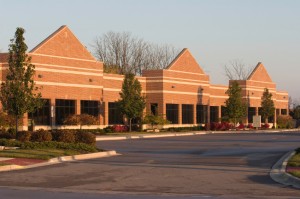
What Causes Asphalt Pavement Deterioration?
There are actually a few likely causes of pavement deterioration, including:
- Natural Wear and Tear: Over time, the materials that make up asphalt begin to deteriorate. The liquid asphalt binder, the glue that holds the pavement together, begins to lose its natural elasticity and starts to break down. During this process, the asphalt also loses its natural resistance to water, making the pavement even more susceptible to rain, snow, freezing and thawing, and more. Once this happens, cracking and other forms of deterioration are not far behind.
- Failures in Construction: Improperly installed asphalt can be a large reason for the deterioration of your pavement. Failures in construction can include: improperly compacted base, over or under compaction of the asphalt, improper temperature during application, poor drainage, and so much more.
Types of Asphalt Deterioration
- 1. Cracking: Cracking comes in many different forms, from alligatoring and edge cracks to slippage, reflection, and more.
- 2. Disintegration: This type of deterioration includes potholes, raveling, and the like.
- 3. Distortion: The result of improper pavement construction and the deterioration of the underlying base, distortion includes channels or ruts, corrugations and shoving, grade depressions, upheaval, and utility cut depressions.
When asphalt is installed properly and well maintained, it can last for 25 years or more! So trust your asphalt to a contractor with a proven track record of success, a contractor like Patrick Gillen of PTG Enterprises.
PTG Enterprises: Your Baltimore Asphalt Contractor
The asphalt experts at PTG Enterprises have managed hundreds of Maryland, DC, and Virginia pavement projects and have the experience you need.
When you hire PTG, you can be rest assured that you will receive the best customer service in the industry. PTG provides prompt proposals, competitive bids, and top notch management to every aspect of the project from beginning to end. We will show up as scheduled, perform the project as contracted, and leave you with a smile on your face!
If you have any further questions, please contact PTG Enterprises aka My Pavement Guy today by calling 410-636-8777, or click here today!
The Benefits of Sealcoating explained by your Baltimore Asphalt Contractor
Wednesday, November 21st, 2012Asphalt will deteriorate over time. Luckily, there are several steps you can take to ensure that your asphalt parking lot or other asphalt surface looks great for as long as possible, from preventative asphalt maintenance to timely asphalt repair to sealcoating. But of all the precautions you can take to ensure your parking surface lasts for a long time, sealcoating is perhaps the most important.
The Benefits of Sealcoating
- Slow Oxidation: Overexposure to oxygen hardens asphalt binders, causing the asphalt to crack. Sealcoating provides a protective barrier for your parking lot.
- Slow Water Penetration: the cracking caused by oxidation allows water to penetrate deep into the asphalt, further weakening the entire parking surface. Sealcoats fill surface voids, limiting water penetration and prolonging pavement life.
- Shield Ultraviolet Rays: UV rays break the lines between carbon bonds and your asphalt. Sealcoating prevents UV rays from further damaging the asphalt pavement.
- Easy to Clean: Sealcoating makes your asphalt surface easy to clean, reducing the depth to which oil or gas can penetrate.
- Cost Effective: The cost of sealcoating is only pennies a square yard versus repairs and rehabilitation which can be as much as twenty times higher.
- Aesthetic Appeal: Sealcoating gives asphalt a beautiful finish.
PTG Enterprises: Your Baltimore Sealcoating Contractor
There are many more options available to property managers and owners today than there was when I started in the Industry. This works to the advantage of the property and to the pavement. Now, depending on the current condition of the asphalt, I have the ability to recommend several different options depending on the condition of the lot, previous maintenance schedules and budgets.
Give me the opportunity to impress you. I can be your one stop ‘Pavement Guy,’ for any pavement project regardless of size or scope.
If you have any further questions, please contact PTG Enterprises aka My Pavement Guy today by calling 410-636-8777, or click here today! The asphalt experts here have managed hundreds of Maryland, DC, and Virginia pavement projects and have the experience you need.















